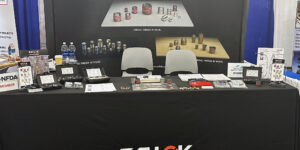Push or Drag Angle with GMAW to Reduce Porosity – The Answer Is: It Depends
Lesson Learned: This analysis shows how one must be careful of getting locked into welding a certain way only because that’s the way it has always been done.
Posted: January 10, 2013
While there we ran into Carl Peters, our director of training who, as usual, was very cordial. During our conversation he recommended that we visit the American Welding Society “Careers in Welding” Trailer that was parked in front of the building. He said that we should check out the VRTEX® 360 virtual reality arc welding simulator that has revolutionized welder training over the past few years.
We took up him up on his advice and made our way up front to see the simulator. We observed people of all ages strike their first virtual welding arc. While one young man was “virtually” welding a T-joint fillet weld with the GMAW process, my father made a casual observation. He said, “Why is he pushing the welding gun?”
At first I was taken aback, but I replied that a “forehand” technique or “push angle” with the electrode was the recommended welding technique for GMAW, because it generally provides the best visibility of the arc and optimum gas shielding.
I also told him that pushing the GMAW electrode promotes bead wetting and produces a weld with a flatter face compared to when a “drag” or “backhand” technique is employed. When dragging the electrode a more convex or ropey weld bead generally results, and a convex weld bead is at best a waste of money and at worst it can become a stress riser in fillet welds.
I finished my diatribe by saying, “And pushing the gun is how I’ve been taught for all of these years.” My dad countered, “In my experience, dragging the electrode has allowed me to deposit defect free welds, especially when the welds needed to be somewhat larger and a weave technique was required.”
After some consideration I thought, why not? During testing of the ER2209 electrode, we were welding single V-grooves, not fillet welds. So during the next round of conformance testing, I decided to implement my father’s words of wisdom. Wouldn’t it be something if it actually worked?
There was no downside, as our largest consumer of the product had not set forth any requirements for radiographic testing. The only reason we were using X-ray was so that we could line up the best location within the weld to dissect mechanical test samples.
Having been inspired at the prospect of a solution to our problem with porosity in ER2209 GMAW welds, I instructed our welders to tweak their welding technique from that of a forehand technique to a backhand technique. Or, said differently, I asked them to change their technique from a push to a drag.
Lo and behold, the backhand technique worked to perfection. The number of porosity discontinuities (shown as small dark spots on the X-ray film) was cut by approximately 80 percent. After making the technique change, the number of dark spots on the film totaled less than four on average. In the world of GMAW welding, one might describe this as “clean as a whistle.”
To prove that this wasn’t a fluke, we’ve had a couple different welders make multiple welds since our initial success. About ten single V-groove test plates had been welded at the time of this writing and each plate has exhibited the same level of weld cleanliness. By the way, we’ve got couple pretty good welders here in our lab, Peter Renda and Nick Peters. This wouldn’t have happened without their respective steady hands.
Through the whole process we learned that when an ER2209 solid GMAW electrode is tested under these conditions, dragging the electrode is the ideal way to go in regards to welding technique. My ad hoc analysis of the reason for our success was that trapped gases within the weld were provided the time and opportunity to bubble out before the puddle had solidified. The puddle stayed hotter longer because a dragging technique causes more of the arc energy to be focused on the weld puddle compared to when a forehand, or push technique, is used.
In contrast, a push technique causes more heat to be spread out ahead of the weld and onto the base material rather than on the puddle itself.
So is a drag technique appropriate for all GMAW applications? Certainly not, and it depends upon the situation. But the lesson learned is that one must be careful of getting locked into welding a certain way only because it’s the way it has always been done.










